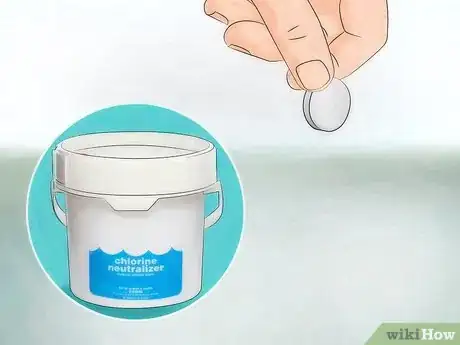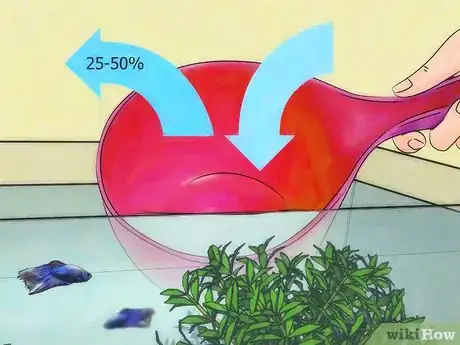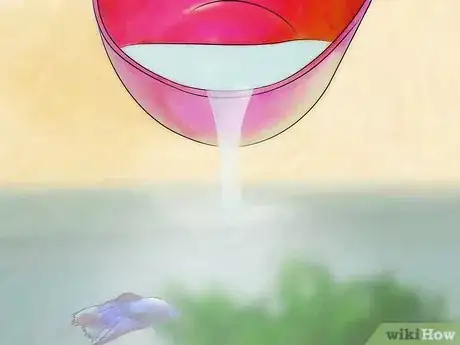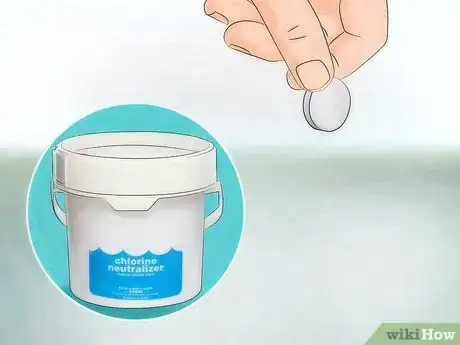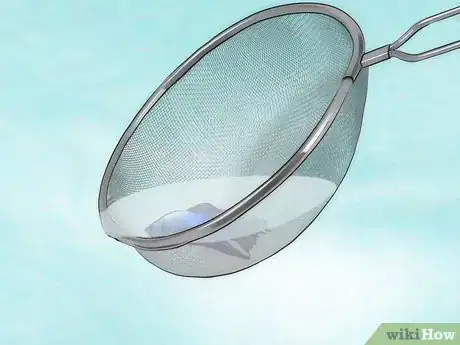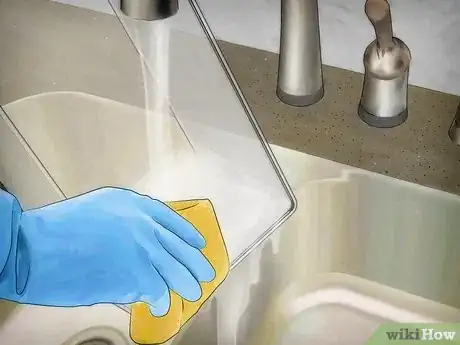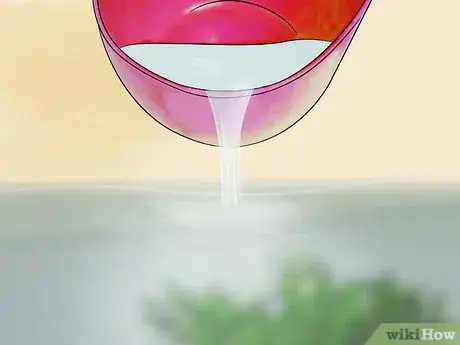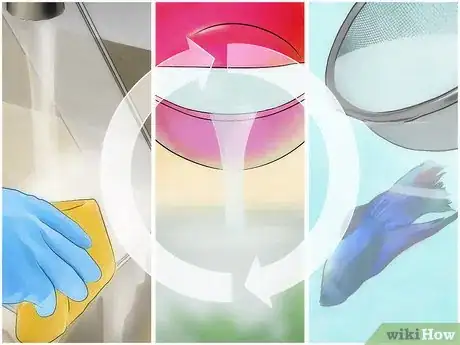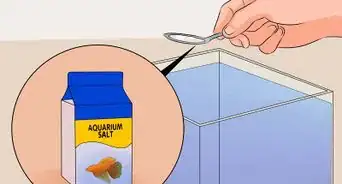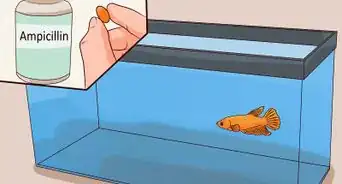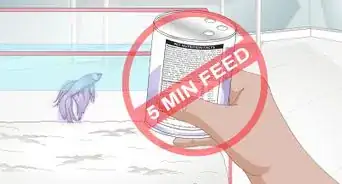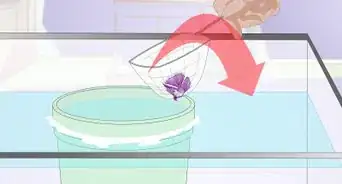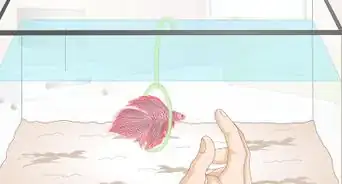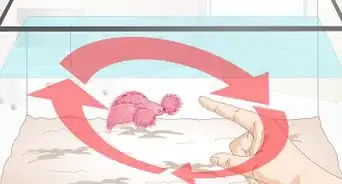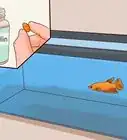This article was co-authored by Craig Morton. Craig Morton is the CEO of Aquarium Doctor Inc. based in Huntington Beach California and servicing Orange County, Los Angeles County, and the Inland Empire. With over 30 years of aquarium experience, Craig specializes in creating custom aquarium designs along with aquarium installation, service, and maintenance.
wikiHow marks an article as reader-approved once it receives enough positive feedback. This article received 23 testimonials and 81% of readers who voted found it helpful, earning it our reader-approved status.
This article has been viewed 681,724 times.
One of the most important things to learn when taking care of a betta fish is how to properly change the water in its tank or bowl. Dirty containers are unhealthy and can make your betta sick, but changing its water improperly can also cause the fish harm. There are two methods for changing a betta’s water: a partial water change, and a total water change. The partial water change is usually preferable, as totally new water can shock the fish.
Steps
Doing a Partial Water Change
-
1Prepare the new water.[1] Fill a large, clean container with fresh water. Leave your betta’s current container alone for now. Use a water conditioner (available at pet supply stores) to remove chlorine and other harmful substances from the fresh water.
- Follow all directions provided with the water conditioner, and use the exact amount required for your tank or bowl size.
-
2Allow the water to warm up. Putting your betta immediately into water that is a different temperature can harm it. [2] Let the container of fresh, treated water sit at room temperature for an hour so that it will be safe and comfortable for your fish.
- Alternatively, you can mix hot and cold water from your tap until it is the same temperature as the water in your betta’s current container.[3] If you follow this method, use an aquarium thermometer to make sure that the water in both tanks is the same temperature, and add water conditioner to the new water as instructed.
Advertisement -
3Remove some water from your betta’s current container. To do a partial water change, you will take some of the water from your betta’s container and replace it with some of the fresh, treated water. Using a clean scoop or something similar, remove 25 percent of the water in your betta’s current container. [4] [5] [6] [7] Leave your betta in the container as you remove the water.
- To be precise, you can measure the water as you take it out. For instance, if you have a twenty-gallon tank, remove up to ten gallons measured using jugs or other measuring containers.
- You can also use a siphon hose to transfer water from your betta’s container to a bucket or sink. Once the water starts flowing, move the hose so it "vacuums" the gravel at the bottom of the tank, picking up fish waste, old food, and other debris.
-
4Refill your betta’s container. Slowly pour fresh, treated water from the container you prepared into your betta’s current container until it reaches the previous water level.[8] [9] If the container is too heavy to lift and pour, use a clean scoop (or similar container) or siphon hose to add the water. It is fine to leave your betta in its container as you add the fresh water, but add the water slowly so that you do not disturb the fish.
-
5
Doing a Full Water Change
-
1Prepare the new water.[14] Fill a large, clean container with fresh water. Leave your betta’s current container alone for now. Use a water conditioner (available at pet supply stores) to remove chlorine and other harmful substances from the fresh water.
- Follow all directions provided with the water conditioner, and use the exact amount required for your tank or bowl size.
-
2Let the water warm up. Putting your betta immediately into water that is a different temperature can harm it.[15] Let the container of fresh, treated water sit at room temperature for an hour so that it will be safe and comfortable for your fish.
- Alternatively, you can mix hot and cold water from your tap until it is the same temperature as the water in your betta’s current container.[16] If you follow this method, use an aquarium thermometer to make sure that the water in both tanks is the same temperature, and add water conditioner to the new water as instructed.
-
3Transfer your betta from its container. Using a fish net, remove your betta from its current container to the container filled with fresh water.[17] Be very gentle when moving your fish, as its fins are very susceptible to injury.
-
4Clean the betta’s container.[18] Pour out the old water from your betta’s container. Gently clean the container itself, using only water and a clean, soft cloth or sponge; soaps and other products can harm your fish. Make sure to sift the tank’s gravel to remove waste, food debris, etc.
-
5Begin filling the betta’s container. Take some of the fresh water from the container your betta is currently in, and pour it into its container.[19] Pour enough so that your betta will be able to move comfortably in its container.
-
6Transfer your betta back to its container. Using a fish net, move your betta from the holding tank back to its container, now partially filled with fresh water.[20] As before, be very gentle when moving your fish.
-
7Pour the rest of the water into your betta’s container. Take the rest of the fresh water from the holding tank and very slowly pour it into your betta’s container. If the container is too heavy to lift and pour, use a clean scoop (or similar container) or siphon hose to add the water. It is important to pour very slowly so that you do not disturb your fish.[21]
-
8
Expert Q&A
Did you know you can get expert answers for this article?
Unlock expert answers by supporting wikiHow
-
QuestionHow often should I change my betta's water?
 Craig MortonCraig Morton is the CEO of Aquarium Doctor Inc. based in Huntington Beach California and servicing Orange County, Los Angeles County, and the Inland Empire. With over 30 years of aquarium experience, Craig specializes in creating custom aquarium designs along with aquarium installation, service, and maintenance.
Craig MortonCraig Morton is the CEO of Aquarium Doctor Inc. based in Huntington Beach California and servicing Orange County, Los Angeles County, and the Inland Empire. With over 30 years of aquarium experience, Craig specializes in creating custom aquarium designs along with aquarium installation, service, and maintenance.
Aquarium Specialist, Aquarium Doctor Inc.
-
QuestionHow do I get the bubbles out of the water?
 Shadow_wolf_52Community AnswerYou don't need to; these are a sign of happiness from your betta and are healthy.
Shadow_wolf_52Community AnswerYou don't need to; these are a sign of happiness from your betta and are healthy. -
QuestionCan I use tap water that is filtered?
 Community AnswerNot unless you also use a water conditioner.
Community AnswerNot unless you also use a water conditioner.
Warnings
- When removing betta, be careful as their fins are delicate and sensitive which are prone to damage.⧼thumbs_response⧽
References
- ↑ http://faculty.etsu.edu/odonnell/2014fall/engl3130/student_essays/Betta_fish_guide.pdf
- ↑ Craig Morton. Aquarium Specialist, Aquarium Doctor Inc.. Expert Interview. 21 July 2020.
- ↑ https://www.pijac.org/sites/default/files/pdfs/betta_new.pdf
- ↑ Craig Morton. Aquarium Specialist, Aquarium Doctor Inc.. Expert Interview. 21 July 2020.
- ↑ https://www.pijac.org/sites/default/files/pdfs/betta_new.pdf
- ↑ http://nippyfish.net/bettas-101/all-about-water/water-changes/
- ↑ http://aquariuminfo.org/betta.html
- ↑ http://aquariuminfo.org/betta.html
- ↑ https://www.pijac.org/sites/default/files/pdfs/betta_new.pdf
- ↑ Craig Morton. Aquarium Specialist, Aquarium Doctor Inc.. Expert Interview. 21 July 2020.
- ↑ http://faculty.etsu.edu/odonnell/2014fall/engl3130/student_essays/Betta_fish_guide.pdf
- ↑ http://aquariuminfo.org/betta.html
- ↑ https://www.pijac.org/sites/default/files/pdfs/betta_new.pdf
- ↑ http://faculty.etsu.edu/odonnell/2014fall/engl3130/student_essays/Betta_fish_guide.pdf
- ↑ http://faculty.etsu.edu/odonnell/2014fall/engl3130/student_essays/Betta_fish_guide.pdf
- ↑ https://www.pijac.org/sites/default/files/pdfs/betta_new.pdf
- ↑ http://faculty.etsu.edu/odonnell/2014fall/engl3130/student_essays/Betta_fish_guide.pdf
- ↑ http://faculty.etsu.edu/odonnell/2014fall/engl3130/student_essays/Betta_fish_guide.pdf
- ↑ http://faculty.etsu.edu/odonnell/2014fall/engl3130/student_essays/Betta_fish_guide.pdf
- ↑ http://faculty.etsu.edu/odonnell/2014fall/engl3130/student_essays/Betta_fish_guide.pdf
- ↑ http://faculty.etsu.edu/odonnell/2014fall/engl3130/student_essays/Betta_fish_guide.pdf
- ↑ http://faculty.etsu.edu/odonnell/2014fall/engl3130/student_essays/Betta_fish_guide.pdf
- ↑ http://aquariuminfo.org/betta.html
- ↑ https://www.pijac.org/sites/default/files/pdfs/betta_new.pdf
About This Article
The best way to change your betta fish water is to replace small amounts each week rather than replace all of the water at once. Add the fresh water to a clean container, mix in a water conditioner, and let the water sit at room temperature for about an hour. Next, scoop out 25 to 50 percent of the water in your betta's tank, taking care to leave your betta inside the tank. Then, slowly pour the fresh, treated water from the container into the tank until it reaches the previous water level. To learn how to do a full water change, read on!
